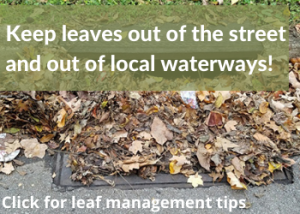By Carl Roberts, EAC Volunteer
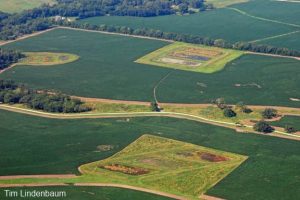
The three experimental wetlands units on the Franklin farm are the lighter areas surrounded by the darker crops. Photo by Tim Lindenbaum.
During the growing of corn and other crops, nitrogen and phosphorous provide important nutrients that enrich the soil. These nutrients are essential for the robust development of the crops.
After the crops are harvested, however, excess nitrogen and phosphorous can drain off the fields into nearby creeks and rivers causing a variety of environmental concerns. Excessive nitrogen (in the form of nitrates) can be toxic in drinking water. Excessive phosphorous and nitrogen causes an explosive growth in algae, which strip oxygen from the water and can result in foul taste or smell.
The positive effects of the nutrients upon the growing crop and the negative effects of the leftover nutrients entering water bodies present a dilemma. How can farmers produce the best crops while limiting nutrient runoff?
Franklin Farm research works to find a solution
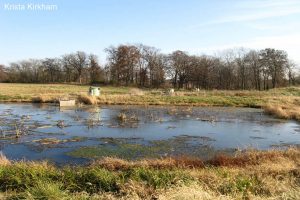
Plants and bacteria in the wetland cells naturally remove excess nutrients from the tile water. Photo by Krista Kirkham.
In order to research this question, three experimental wetlands units were constructed in 2005 on the Franklin Research and Demonstration Farm in Lexington, IL. Some of the fertile farmland – that would normally all be used in growing crops – was taken out of production to be used as the locations for the wetlands. This was made possible by the generosity of the landowners, the Franklin family; through cost-share programs offered by the United States Department of Agriculture (USDA) Conservation Reserve Program and Environmental Quality Incentives Program; funding through the Illinois Department of Natural Resources C2000 Program and McLean County Soil and Water Conservation District (SWCD); and in-kind assistance from AGREM, LLC.
The USDA has financial-assistance programs for farmers who create wetlands on their farmland. Cost sharing is available for establishing the wetlands, and annual rental payments and signing incentives are available to farmers for constructing the wetlands.
What makes the Franklin farm an especially appropriate location for experimenting is that it is a fully operational farm – where corn and soybeans are raised – and it is located next to the Mackinaw River. The use of nutrients on the crops and their effects on the water running off the farm provide a real-life laboratory.
The Franklin Research and Demonstration Farm is a project of the Nature Conservancy, a non-profit conservation organization working to protect land and water in more than 30 countries. Collaborating with the Nature Conservancy is a team of scientists from the University of Illinois at Champaign-Urbana and Illinois State University, McLean County Natural Resources Conservation Service and McLean County Soil and Water District.
Three sets of wetlands

Each of the three cells in the experimental wetlands removes additional nitrogen and phosphorous from tile water that flows through them. Photo by Tim Lindenbaum.
The water that flows through the wetlands originates under the farmed fields. It does not come from any surface water source, such as a stream. Rainfall that has percolated into the soil, along with groundwater, enters a network of underground, perforated plastic tubing known as “tiles” and is directed into the wetlands. On most farms, which do not have wetlands, these drainage tiles carry excess water from the fields to a nearby stream or creek. Without tiles draining the fields, the land would be too wet to be farmed.
Three sets of experimental wetland units are operating in different sections of the Franklin farm. Each unit is made up of three cells. The water flows from the tiles into the first cell, where it is naturally treated to remove excess nutrients. It then flows into the second cell for additional treatment, and then into the third cell for final treatment.
The natural treatment in each cell of the wetlands is literally treatment by nature. No chemicals or machines are used in the process. The tile water empties into each wetland cell, allowing for interaction with the plants and bacteria in the wetlands. Bacteria in the wetland sediments consume some of the nitrate-nitrogen and release it into the atmosphere as nitrogen gas. Plants in the water absorb some of the nitrogen and phosphorous as well, thus reducing them from the water. After exiting the third wetland cell, the water then flows into a grass waterway and eventually empties into floodplain wetlands, which ultimately filter the water into the Mackinaw River.
Measurement of nutrients shows effectiveness of wetlands
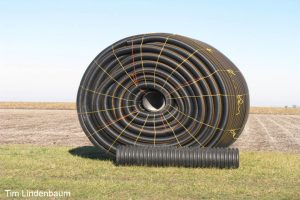
Tiles of plastic tubing are placed underground to carry excess water from the fields into the wetlands. Photo by Tim Lindenbaum.
The size of each cell is three percent of the area of the field that is tile-drained. Water that has traveled through one cell has been treated by a wetland that represents a wetland/watershed ratio of three percent. Water that has been through two cells has been treated by a wetland that represents a wetland/watershed ratio of six percent (three from the first cell and three from the second). Water that has been through all three cells has been treated by a wetland that represents a wetland/watershed ratio of nine percent (three plus three plus three).
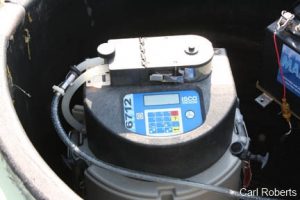
Sophisticated equipment is programmed to collect water samples from each wetland cell. Photo by Carl Roberts.
Laboratory analyses of the water as it exits from each cell show an additional decrease in the percentage of nitrogen and phosphorous. Careful measurement of nutrients in the water over a five-year period (2007-2011) produced the following results:
- 3% (through one cell) – removal of 19% of nitrate-nitrogen and 49% of dissolved phosphorous
- 6% (through two cells) – removal of 37% of nitrate-nitrogen and 59% of dissolved phosphorous
- 9% (through three cells) – removal of 47% of nitrate-nitrogen and 58% of dissolved phosphorous
Other natural methods of protecting water and soil

The Franklin farm includes savannas, where sunlight shining through the trees provides a home for a variety of prairie plants, birds and animals. Photo by Carl Roberts.
In addition to the use of wetlands, other agricultural conservation practices are being utilized on the Franklin farm:
- Grassed waterways, strips of native grass placed in erodible areas of the farmland, are slowing surface water runoff and helping control soil loss.
- Field borders are created when a variety of prairie grasses are planted around the fields. The field borders add nutrients to the soil, help minimize soil loss, and create wildlife habitat.
- Winter cover crops of cereal rye, radish or annual rye were planted in fields after harvest to monitor the effectiveness of cover crops in further reducing nutrients entering the wetlands through tile water. Cover crops also reduce erosion and soil compaction, add nutrients, and reduce nutrient loss in the spring.
- Rock stabilization structures are built by placing walls of rock in a gully on the south end of the farm. The rocks slow down the water and filter sediment out it.
Demonstration farm
One of the most important functions of the Franklin Research and Demonstration Farm is providing outreach in the form of demonstrations and information to local farmers, landowners, and other agricultural agencies and groups. Visitors come from all around central Illinois to learn about the techniques being used on the farm. Some farmers have shown serious consideration to constructing wetlands or other conservation practices on their own farms.
For more information about this project, visit https://www.nature.org/ourinitiatives/regions/northamerica/unitedstates/illinois/placesweprotect/the-mackinaw-river-watershed.xml




